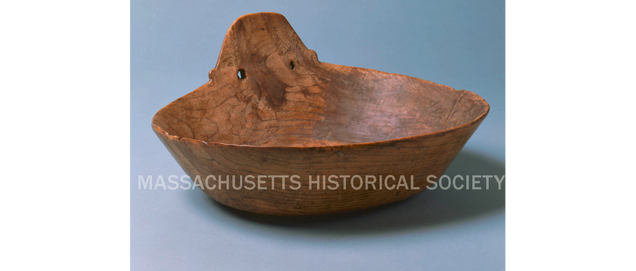Elm burl samp bowl [a trophy from the wigwam of King Philip, when he was slain in 1676]

Courtney Borge and Saki Matsumoto
One of the artifacts that has been part of the Massachusetts Historical Society’s collection for over 200 years is King Philip’s samp bowl. It is carved from elm burl wood and is an impressive example of Algonquian craftsmanship. At one end of the bowl, the wood curves upward and there are two holes in the raised portion. Although it may look like a regular bowl at first, there is a rich history behind the use and the possession of this bowl; when it was obtained by the MHS, the MHS carved their own version of the bowl’s history into the bowl which reads “A Trophy / from the Wigwam of King Philip / When he was slain in 1676 / by Richard. Presented, by Elezr / Richard, his Grandson.” This paper will question the validity of this written history, as it is likely a very colonial perspective. The paper will also talk about how this bowl might have been used in the Wampanoag tribe given what we know about their daily life.
The Wampanoag are a group of Native Americans who reside in southeastern Massachusetts. When the first settlers arrived, their sachem Massasoit established peaceful relations with them, even though the Wampanoag had been there long before them. When the number of colonists grew and their need for land increased, the relationship between them and the Wampanoag grew hostile. By the time King Philip, Massasoit’s son, became sachem, the two groups grew hatred for each other. He would eventually start King Philip’s War, a war between the Wampanoag and their allies and the colonists and their allies. The war proved to be extremely costly for both sides, and ended with the assassination of King Philip himself.
A hunter-gatherer tribe, the Wampanoag people were observed to have a balanced diet consisting of fish and fruits and vegetables. As the colonists reached their shores, trade of various equipment occurred between the groups. They resided in a “wetuash,” built from overgrown trees, bark and bushes. A ceremony would be performed over all chopped down materials to enable the process of new life among the land they took from.
Wooden dishes, such as the samp bowl, date back in use to the seventeenth century. As the colonial population migrated to these new shores, new diseases traveled with them. Weakened by diseases such as the smallpox outbreak of 1635, the Wampanoag people resorted to creating wooden dish ware and utensils that could be burned after use to generate warmth for the community.
The decolonization of museum artifacts, or questioning and removing the colonial lens which has dictated the history of indigenous material culture and how and for whom museums conserve Native objects, should be considered for King Philip’s bowl. It is unfair to the Wampanoag for their history to be held by the MHS, especially because the artifact was stolen from them before being handed over to the MHS.
In accordance to the daily life of the Wampanoag people during early settlement, the elm burl bowl is merely one of thousands of wooden utensils that would have been created. It’s unique pathway into the ongoing possession of colonial historians represents the bias that has defined the retelling of history throughout time. The bowl was noted to have served as a vessel for “balloting corn and beans at society meetings,” (MHS). Permanently imprinted, the bowl has become more of a representative of the ways in which colonization stole from and appropriated the cultural history of native settlements.